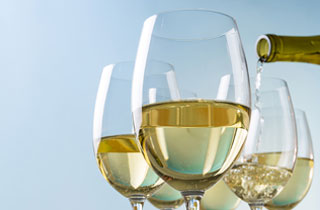Stone fruits (those with pits like cherries, peaches, plums, etc.) are generally off-dry to sweet wines that are easy to enjoy on a warm summer evening. Two pros share advice on making your own version at home.
Winemaker: Lewis Eaton, Sweet Baby Vineyard, in Hampstead, New Hampshire
We make two peach wines — our White Peach is back-sweetened to 4.5% (45 g/L residual sugar), and our dessert wine Baby’s Blush, is a 50/50 with peaches and Léon Millot, is back-sweetened to 9.5% residual sugar (95 g/L).
We use a New Hampshire-grown blend of white and yellow peaches. Since they are grown in a cold climate with a short growing season, they tend to be a bit more acidic than the warmer climate varieties. The higher acidity keeps the wine from being flabby or cloying, and closer to a traditional white wine. They are harvested at the very end of the season when the Brix comes in higher and acidity is at a point that is very manageable. The higher the Brix, the less sugar we have to add to get the target ABV. We shoot for 11.5-12% ABV in both wines, but to start at around 8–9 °Brix (1.03 specific gravity) would be a great year. A typical year for our pH is around 3.35–3.5. The target titratable acidity is 0.7–0.75%.
I hand cut every peach with a pairing knife. The fresh fruit is halved, pit removed, and then tossed into the fermenter with the skin on to givethe wine an added mouthfeel and tannin. The whole fruit is hand punched down twice daily, getting the most out of the fruit. We use Lalvin EC-1118 yeast and stage our nutrients at 50% dosage rates at 50% sugar depletion. The yeast pretty much eliminates all traces of solids, coupled with 1 mL of pectic enzyme per gallon (4 L), with the exception to the very fluffy lees left behind. We ferment to dry, stabilize (50 ppm of SO2), and start the clarification with bentonite at the first racking. The second rack is a splash rack to get rid of any trapped gasses. We pad filter down to 0.2 micron to get this wine very polished and eliminate haze as much as possible. Stone fruits can be very difficult to clear, and often times need several different micron denominations to polish. But do not get too hung up about getting the commercial looking wine while you perfect your blend.
Since our starting Brix is usually around 9, it takes quite a bit of cane sugar to get to our goal of 12% ABV. It takes roughly 22 ounces (0.62 kg) of cane sugar per gallon (4 L) to hit the number. We use 5 lbs. (2.3 kg) of fruit per gallon, yeast, yeast nutrient, and 1 mL of pectic enzyme per gallon (to break the fruit down). After fermentation we back-sweeten with cane sugar to 4.5%.
For Baby’s Blush the Léon Millot is harvested at 22–23 °Brix, so the combined Brix with the peaches is around 15.5, requiring a little over 10 oz. (0.28 kg) of sugar per gallon (4 L) to get close to 12% ABV. Since the fruit comes in 1–2 months apart from each other, unless we are very lucky to be able to cold store the fruit (which we have in the past), we usually ferment the peach and Léon separately, but we have done it both ways. The only difference is the sugar additions. The grape wine doesn’t need the sugar pre-fermentation, but the peach does.
All of our fruit wines are fermented with EC-1118. We use this because it is very neutral and shows the uniqueness of the New Hampshire-grown fruit that we use. It also does a great job of breaking down the peaches and creates very little foam.
Winemaker: Brian Smyth, Chateau Morrisette, Floyd, Virginia
Our cherry wine is predominantly made from tart cherry juice we get from Wisconsin. After doing bench trials, tart cherry juice is fermented with small volumes of other cherry varieties to dryness. When buying juice, look for something free of preservatives to avoid fermentation issues.
Our cherry juice typically comes in with a high Brix, so we do not need to chaptalize. When we receive juice, we run a standard set of analyses in the lab including: Brix, pH, titratable acidity (TA), volatile acidity (VA), and yeast assimilable nitrogen (YAN) to see what exactly we are working with. While our cherry juice typically has a high YAN, proper nutrient status is vitally important to successfully fermenting a fruit wine. Adjust your nutrient protocol based on the nitrogen levels in your particular juice. After we have determined the total quantity of nutrients required, we look at the YAN contribution of complex nutrient blends with little to no DAP. Then, the difference between our target YAN and that from the complex nutrients is made up with DAP. These nutrients are split between three additions. We add only complex nutrients to the juice pre-inoculation.
After cold-settling, we heat exchange the juice to 65 °F (18 °C) for inoculation. The day after inoculation we aerate the ferment. As soon as lag phase is complete, we adjust the temperature to the lower extreme of the particular yeast’s tolerance (we often trial new yeasts, but we used Vin13 for our last batch) to promote a longer fermentation and retain aromatics. Around 4 °Brix, we turn the cooling jackets off and allow the ferment to warm up some to aid in completing fermentation.
The high TA of our cherry wine requires sweetness to balance the acidity. Instead of stopping the fermentation, we back-sweeten by filtering a sucrose solution into the wine immediately before bottling. This also allows us to safely store the wine and gives us more control in honing in the sugar level required.






